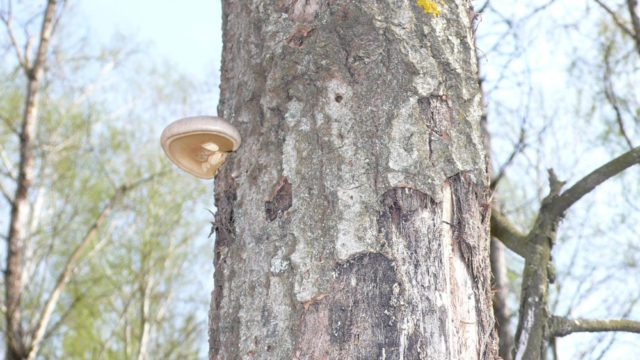Content
The Veshenkov family is numerous. There are more than a hundred varieties in it, but only about 10 main species are known and well studied. Covered oyster mushroom (Pleurotus calyptratus) is one of them. It is also called single or sheathed.
Where the covered oyster mushroom grows
This variety is not so common. It grows not in groups, but one by one:
- in the north and central regions of Europe;
- in the north of our country;
- on the territory of Western Siberia.
It is listed in the Red Book of the Krasnoyarsk Territory and the Novosibirsk Region. Grows in mixed and coniferous forests on dry, dead aspen or fir wood. Appears en masse in early spring, at the same time as morels and lines. Throughout the summer, it rarely bears fruit, therefore it is rarely found.

Oyster mushroom single on aspen wood
What does coated oyster mushroom look like?
The fruiting body of the covered oyster mushroom consists of a cap, which can reach a diameter of up to 15 cm. The mushroom acquired its name thanks to velum, a cover that protects young bodies, which is not typical for other species. But growing up, the mushroom gets rid of the film. It remains partially, in the form of patches on the lower surface, covered with yellowish plates arranged in a fan, freely and not so often. Whitish, colorless spores form on the geminophores.
The outer surface of the fruiting body is dense, smooth, brown or gray in color. Sometimes in the sun, radial fibers of a lead shade are clearly visible. The edges of the adult fruiting body are folded down. It takes on a white hue under the sun. The fungus looks like a small hoof firmly planted on the surface of a dry tree. There are no legs, although in other species there are barely noticeable legs in the form of small stumps.

Remains of the bedspread at the bottom of the oyster mushroom covered
Is it possible to eat covered oyster mushroom
This species belongs to the 4th class of edibility. But covered oyster mushroom is considered inedible or conditionally edible due to the rubbery consistency of the pulp, although some mushroom pickers collect it and eat it boiled, fried. There are lovers of raw mushrooms. This is dangerous: without heat treatment, they can lead to poisoning.
Mushroom taste
The smell of the variety resembles that of raw potatoes. The taste is poorly expressed.
Similar species
Covered oyster mushroom is very difficult to confuse with other species, since it grows mainly in May, earlier than other varieties of this family. Its distinctive feature is also the remains of velum, which covers the spore-bearing layer of young fruiting bodies, located on the blades. It is similar to this variety of Oyster mushroom, which also stands out with pieces of torn bedspread, grows massively on oak trees and is found in summer. It has a leg, so it is difficult to confuse it with covered oyster mushroom.
Collection rules
May is the best time to collect covered oyster mushrooms.The caps of the fruit bodies are carefully cut with a knife, leaving the bases. It is recommended to collect young mushrooms. Their flesh is not so hard and the taste is more pleasant.
Use
The Veshenkov family, according to mycologists, has a rich composition. They saturate the human body with energy resources, necessary vitamins, contain useful mineral salts of calcium, potassium, iron, copper and other trace elements. In terms of the variety of useful components, this fruit body is often compared to fish.
In folk medicine, it is used to lower blood sugar levels, in the treatment of vascular diseases. Separate elements are used for neurological abnormalities. All these properties of the varieties of the Veshenkov family explain the cultivation of this fruiting body on an industrial scale in Europe and Russia. Their mycelium, including a single species, are sold in special stores. Oyster mushrooms are the most unpretentious mushrooms. They can even be grown at home.
But it is impossible to abuse food, which includes these fruiting bodies. Children, pregnant women, the elderly, and those with mushroom intolerance need to be careful when eating mushrooms.
Conclusion
Covered oyster mushroom is a saprophyte. She, like many other fruiting bodies, performs the role of the orderly of the forest. Thanks to her, the process of decay and decomposition of wood is faster. It is practically of no culinary interest, but with proper preparation it can become an interesting dish, does not pose a danger to human health.









